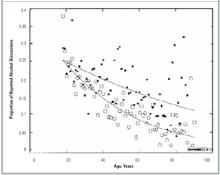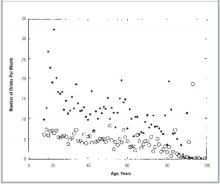Results
Approximately 1 in 6 patients (16.1%; 95% confidence interval [CI], 15.4 - 16.8) reported that a physician or other health care worker had initiated a discussion about alcohol use. Table W1* compares patients who reported such a discussion with those who did not. Physicians talked to male patients about alcohol use most frequently. This corresponds to men reporting nearly 3 times more drinks consumed (12.9 drinks/month) than women (4.7 drinks/month; t = 16.26, df = 18,323, P < .001).
In general, physicians spoke about alcohol more often to younger people. There was a significant interaction, however, between sex and age, as shown in Figure 1. Discussions with women demonstrated a clear decrease in frequency with age; discussions with men decreased with age more slowly.
The amount of drinking in our sample, indexed by the number of drinks per month, is shown in Figure 2. Both the frequency of discussions and amount of alcohol consumed declined with advancing age. Women drank less alcohol than men overall and showed a moderate decline in use with age.
Nonwhite respondents reported more physician discussions about alcohol than did whites. However, white patients reported greater consumption (8.9 drinks/month) than nonwhites (6.8 drinks; t = 2.79, df = 18253, P < .005).
The lowest income group reported being advised about alcohol most frequently. Interestingly, the highest income respondents tended to drink more than those with less income. Marital status also predicted alcohol discussions. Physicians discussed alcohol more often with patients who were unmarried. While divorced patients reported discussions about alcohol use frequently, widowed patients reported them least often.
Discussions about alcohol occurred more often with respondents who had consumed alcohol within the month prior to the interview. Respondents who reported having these discussions also consumed more (14.6 drinks/month) than those who did not report a discussion (7.3 drinks/month, t = 7.20, df = 17985, P < .001). People who binge drank were more than twice as likely (OR = 2.25; 95% CI, 1.94 - 2.60) to report such a discussion (27.5%).
All of these predictors of a discussion about alcohol use were entered into a multivariate logistic regression. Backward elimination removed items that failed to provide independent information. The final model appears in the Table. Factors other than drinking behaviors that uniquely increased the chance of such a discussion about alcohol were being young, male, nonwhite, and of lower income.
More than 1 in 9 people (12.3%; n = 2768) in the sample met criteria for excessive drinking (ie, consuming 60 drinks per month or drinking 5 or more drinks on a single occasion in the last month). Within this group, 11.9% engaged in binge drinking and 3.5% consumed 60 drinks a month. Most were men (71.3%) with a mean age of 35 years, and they averaged 39.7 (95% CI, 36.74 - 42.74) drinks per month. They binged an average of 3.44 (95% CI, 3.18 - 3.70) times during the last month.
Slightly more than 1 in 4 excessive drinkers (28%; 95% CI, 25.41 - 30.69) reported a discussion about alcohol with a physician. While none of the demographic factors met our stringent criteria for significance (P < .01), many would have met the more usual threshold of P < .05. For example, among the respondents with excessive alcohol use, 23.9% of the women had been screened by their physicians compared with 29.9% of the men (P < .013). This suggests that these women may receive less preventive discussions and screening than they require. While the percent of nonwhite respondents who drank excessively and were successfully screened was above the mean rate overall (35.6%), the percent of white patients was lower than the mean (26.4%; P < .012). Compared with married patients, excessive drinkers who were divorced (35.2%; P < .019) or separated (38.1%; P < .091) reported a higher frequency of screening. Widowed patients with excessive alcohol use rarely reported screening (13%; P < .032).
TABLE
FINAL LOGISTIC REGRESSION PREDICTING A DISCUSSION ABOUT ALCOHOL
| Predictor | Beta | OR(95% CI) |
|---|---|---|
| Sex | -0.48 | 0.62 (0.44 - 0.87)* |
| Age | -0.028 | 0.97 (0.97 - 0.98)† |
| Age, by sex interaction | 0.02 | 1.02 (1.01 - 1.03)† |
| Did not drink ‡ | -0.57 | 0.57 (0.44 - 0.73)† |
| Drinks per month § | 0.28 | 1.33 (1.24 - 1.43)† |
| Income | -0.08 | 0.93 (0.90 - 0.96)† |
| Race ¶ | 0.34 | 1.41 (1.22 - 1.63)† |
| Constant | -0.24 | |
| OR denotes odds ratio from univariate logistic regression; CI, confidence interval. | ||
| *P< .01 | ||
| †P< .001 | ||
| Respondent reported not drinking any alcohol in the last month. | ||
| § Log transform of the number of drinks per month. | ||
| ¶ Race coded as white versus nonwhite. | ||
FIGURE 1
LOGISTIC REGRESSION PREDICTING THE OCCURRENCE OF PHYSICIAN DISCUSSION ABOUT ALCOHOL FROM THE PATIENTS’ AGE AND SEX (WOMEN =o MEN =●).
FIGURE 2
MEAN NUMBERS OF ALCOHOLIC DRINKS CONSUMED BY AGE AND SEX (WOMEN = o MEN = ● ).



